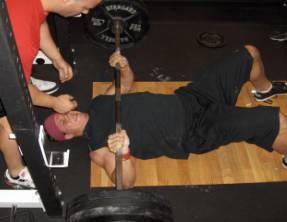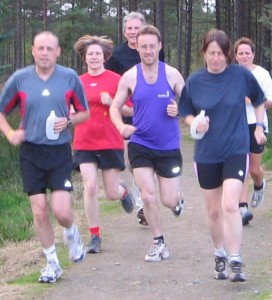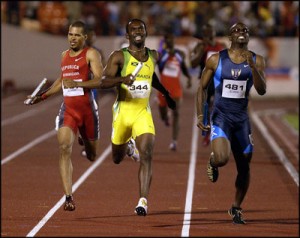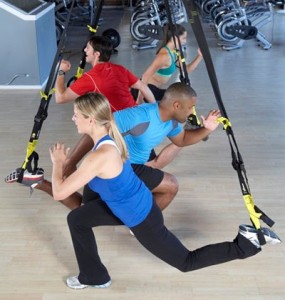Words of Wisdom from Coach Boyle…
July 24, 2012 by danny · Leave a Comment
Strength Coach Mike Boyle sent out his newlsetter today, and this is what he had to say…
“No one has ever gotten better lifting light weights.
Light weight is an oxymoron. A weight should be appropriate to the
goal but, rarely, if ever, intentionally light. The load should be
based on the strength level of the person. The reality is if you
are lifting a weight ten times, numbers nine and ten should be
difficult. If you can lift a weight 20 times but choose to do only
ten, you are wasting your time. Period.
The essence of effective strength training is a concept called
progressive resistance exercise. This means that that even if
the resistance may be light to begin with, it should not stay
that way.
I go crazy when someone tells me about the routine they’ve been
doing with their eight-lb hand weights. (P.S. Call them dumbbells.
Calling them hand weights is a dead giveaway that you are clueless.)
My first question is this. How long have you been doing this?
Often, people respond with something like, “I’ve done this three
times a week for three months.” The doctrine of progressive
resistance says that the first two weeks were beneficial and
th at 10 weeks were wasted. It’s no wonder people stop working out.
Once you have passed the first three weeks of training, you
should lift a weight that is heavy but allows perfect form.
Be wary, however, of another all-too-common mistake. When we
say the load should be heavy, people begin to cheat. We are
not encouraging cheating. Strive for perfect technique in all
exercises AND progressively increase the resistance. SportBlocks,
from PowerBlock, are perfect for this as are the Bowflex Dumbbells.
SportBlocks are a small version of the popular PowerBlock dumbbells
that increase in three-pound increments. If you don’t want to buy
SportBlocks, get a good selection of dumbbells. Beginners will
need 2.5-, 5-, 7.5-,10- and 12-lb dumbbells in order to progress.
Point 4 – Work on basic strength in basic exercises. If your trainer
has you practicing your golf swing with a dumbbell in your hands,
get a new trainer. Do not wave dumbbells around and call it strength
training. Learn to bodyweight squat, learn to do a push-up. Good
basic training should strongly remind you of the calisthenics you
used to do in high school.
Here’s the truth. The secret is, there is no secret. If you want
to hit a golf ball further, you need to get stronger. You will not
get strong lifting a five-pound dumbbell.”
Well said, Mike!
Even though some of your sets might be light relative to your 1-RM (Rep Max), do not purposely lift a “light” weight that doesn’t challenge you. That is dumb. Don’t be dumb. Ok, so Coach Boyle’s words were more eloquent than mine, but you get the point. ![]()
Have a great week!
Brilliant at the Basics – Episode III – Bulgarian Split Squats AND McKenna’s First Experience at Wrigley (Wrigley vs Fenway)……
June 19, 2012 by danny · 5 Comments
Today’s post is the 3rd and final installment of “brilliant at the basics.” But before we get into that, I want to quickly recap my trip to Wrigley Field this past Friday. If you read episode II of brilliant at the basics, you’ll recall I mentioned that one of my best friend’s was in town from Omaha for his first visit to Wrigley. Now, he’s a BIG Red Sox fan, so I was curious to get his thoughts on Wrigley compared to Fenway Park (a place that I still haven’t been). McKenna had A LOT of good to say about Wrigley in the days to follow his first experience in the ball park. But I’m going to let him recap Wrigley and Fenway’s similarities and differences in the comments section below. Note to McKenna, sorry about the mustard “situation” (you’ll get it when you read McKenna’s summary).
If you’ve been to both stadiums, please add your .02 in the comments section below as well. I can’t wait to join McKenna at Fenway the next time the Cubs play there, so I too can compare the two ball parks. I just hope that my first visit there will be Cubs vs Red Sox in the World Series (I know, I know, I won’t be holding my breath!). By the way, at the end of the game, we were waving the W flag! Cubs win! Cubs win!
Brilliant at the Basics
Alrighty then, with that out of the way, let’s get to the last installment of brilliant at the basics. I used the bulgarian split as the exercise of choice to get my point across. But you can apply the points that I make to any exercise in the weight room. Check out the video below…
So, if you have any thoughts about my whole brilliant at the basics series, leave a comment.. And, remember to check out McKenna’s summary of Wrigley vs. Fenway in the comments section below. Is he on the money? Do you have different thoughts? If so, let us hear them…
Brilliant at the Basics (Dribbling Skills) – Episode II
June 14, 2012 by danny · Leave a Comment
In case you missed “Episode I,” CLICK HERE. I’ll include the “introductory video” again today… to get you up to speed…
When it comes to dribbling skills, things are no different than with a quality strength training program. That is, you must first build a foundation (get brilliant at the basics), before you can even think about getting “all fancy.” It’s about working toward making progressions from week-to-week (again, just like you should be aiming to do when in the weight room).
There you have it, handles 101. Ok young ballers, go get it!
On a side note. I’ll be at Wrigley for Friday’s Cubs/Red Sox game! I can’t wait! I haven’t been to Wrigley for years and this will be my first time back at my favorite place on Earth since moving back to Illinois. And to make it even better, one of my best friends, McKenna, is driving in from Omaha to go to the game with me. He’s a long time Red Sox fan and this will be his first time at Wrigley. I’m interested to see how he thinks Wrigley Field compares to Fenway Park (or is it Pok?)
Anyway, good times are ahead, and to keep with the theme of brilliant at the basics, we’ll definitely keep it simple by starting off with an Old Style and a Chicago Style Hot Dog.
But not to worry y’all… I’ll get right back on my usual clean eating/living the next day. It’s about finding that balance… and an Old Style with a dog definitely fits in the plan from time to time!
Have a great rest of your week and a great weekend my friends. I know I will! ![]()
Brilliant at the Basics – Episode I
June 7, 2012 by danny · Leave a Comment
Strength Coach Mike Boyle recently wrote a really good blogpost. In it, he quoted Coach Dewey Neilsen:” Be Brilliant at the Basics.”
In the video below, I elaborate…
I was a guest speaker at a basketball camp today, and this whole brilliant at the basic thing, was the “theme” of my speech. Far too often we are in such a hurry (in sports and/or training) to get to the advanced stuff, but we fail to “master” the basics. So my next few blogposts will be real world examples of getting brilliant at the basics. I’ll include both basketball and fitness examples. First up… push-ups.
The first question to come out of ANY young (male) trainee’s mouth is; “how much ya bench?” Well, I like the bench press, but 95% of these guys can’t even perform a proper push-up yet. So why are they worrying about how much they can max out on on the bench press? I guess it’s in our DNA… in order to become a MAN, you HAVE TO max out on the bench! ![]()
I also have some of my young high school guys asking me, “when do we get to bench press with those chains!?!”
While I LOVE that they are excited to try new things here in the weight room, there is no need for those advanced methods just yet. Let’s first learn to master a push-up!
Here are some common push-up errors that I see on a weekly basis…
So, “Be Brilliant at the Basics,” episode I is in the books. Check back in a couple days for some more examples along these lines.
If you have friends that could benefit from this post, please share it with ALL OF THEM!
How to Get Athletes Faster
October 13, 2010 by danny · Leave a Comment
As a strength coach and basketball coach I’ve had many parents ask me over the years; “how do I get my son/daughter faster?” More often then not, these well-intended parents/coaches figure the best way to improve speed is to have the young athletes do agility drill after agility drill. But they leave out a VERY important component to improving speed – strength training. Both Eric Cressey and Mike Boyle do a great job of addressing the importance of getting stronger in the quest to becoming faster. You can check them out here…
As Coach Boyle points out; ”The best solution to slow feet is to get stronger legs.”
If you are a parent, or a coach of a sport, and the “sciency” type of stuff that Mr. Cressey & Boyle are talking about has you a little confused, just know that the more force you are capable (by getting stronger through weight training) of putting into the ground, the faster you are going to be able to run, the quicker you are going to be able to stop, and the higher you are going to be able to jump. And I couldn’t agree more with Eric – many sport seasons go year around these days (i.e. a basketball player or volleyball player that has their regular season, then it’s off to spring league, followed by summer league, followed by fall league. And then mix in a few camps in the summer, and a number of open gyms… as you can see, it is NON-STOP!). I think it’s fair to say that these athletes are spending more than enough time working on agility. Their non-playing time would be better spent getting stronger, as opposed to going to “speed” camps in which the coaches/trainers focus on movement training – where the majority of what they do is more agility drills, with no weight training.
If you read Eric and Mike’s posts, and my thoughts from above, I’m pretty confident that you are “sold” on how important strength training is to becoming a faster athlete. But just in case you are still not buying it, think about some of the fastest athletes in the world… sprinters in track and “skill” players in football (defensive backs, running backs, receivers). These are athletes that are moving some serious weight in the weight room!
So, if you are a parent or coach to an athlete(s) and do not have access to a qualified strength coach in your area, where do you begin? The biggest advice I can give you is to keep it simple for now, work on form, and focus on big, compound movements with free weights (i.e. lunges rather than leg extensions) Here is a good place to help you get started – http://bit.ly/cj4T3v. And don’t be thrown off by the title of the article. This would be a good place to start for most young athletes. Now go get some people stronger!
Should I Run?
May 25, 2010 by danny · Leave a Comment
To run or not to run, that is the question. Running/jogging is something people having been doing for years and years. And I believe it is something that people looking to drop a few pounds will continue to do ’til the end of time. But, is running the best way to “get in shape” and lose weight? Is it even a good way at all? While reading my thoughts below, please don’t think I am biased towards the weight room and power/strength activities due to the fact that I am a strength coach. If anything, my natural bias would be towards distance running as I grew up in a house where my dad was a cross country coach. And one of my brothers is currently the head cross country coach at a high school. I’ve completely thought about both sides of the discussion – running is the best way EVER to lose some weight; and running is a crap form of cardio for weight loss. I’m not saying I have all answers, but again, I’ve put a ton of thought into this over the years, worked with a ton of clients and talked with many other coaches in this field about this topic. So, if at the end of this you disagree with me, that is fine. All I ask is that you read with an open mind and consider my thoughts when making up your mind whether or not you should put much time into running to accomplish your goals. For the sake of this post, I’m talking about a distance that takes 20 minutes or more of non-stop running.
Different “Types” of People
Running For Sports – (Remember, throughout this piece I am speaking of going out on runs/jogs that last 20 minutes or more, non-stop) For most sports, I think running is a bad idea. What sport do you know that involves 20 + minutes of non-stop running? I can think of cross country. If I think hard enough I may be able to come up with a couple more. But most sports involve quick bursts followed by a brief rest. i.e. player sprints all out for 10-15 seconds, the ball goes out of bounds, he/she takes a break, the ball is thrown in bounds and this is repeated throughout the course of the game. For cross country, heck yeah you need to get your distance running in. If you compete in cross country, make sure you run distance, but also make sure you incorporate sprints and weight lifting. If all you do is run long distance at a slower than race pace, you’ll become good at running slow. Not good! Here is a great read from strength coach Eric Cressey for cross country (or those that are out of high school and enjoy competing in road races) runners and coaches talking about the importance of resistance training for runners.
The Person Looking to Drop Some LBS. – I think I first heard this quote from Strength Coach Mike Boyle; “Don’t run to get fit, get fit to run.” In other words, if you have weight to lose, and you decide, “hey, I think I am going to start running on Wednesday,” then you are probably not making a wise decision. Any form of cardio we decide to do is going to cause stress to our joints. But some forms of cardio will cause more than others. And for a person that is a bit heavier, running will cause a high amount of stress to the joints. It will also increase the chance of stress fractures and all kinds of other problems. Not only that, but running is VERY repetitive. I believe it is estimated that running one mile takes about 2000 steps. Go out and run 3 miles, two times per week and we’re talking about 12,000 steps in the same fashion… you are basically an injury waiting to happen. In this case, I’d suggest lower impact activities like using the Airdyne Bike.
The Already Fit Person – For the person that is lean, and in good shape (although that is very subjective), I still don’t like the idea of long(er) steady state running a whole lot. The exception is the person that truly loves running. He/she gets a whole lot of joy out of it and looks forward to his/her weekly (or even daily) running sessions. However, from the people I’ve talked to and worked with, the majority (read: not ALL) of people run because they think this is the best, or only option of cardio for fat loss – rather than running because they truly enjoy it. Hey, we only live one life, and who and am to take away one of your loves in life?!? But for those of you that are reading this that fit in the category of; “I hate going out for long runs but I’ve always done it because I thought I was supposed to in order to lose weight,” you’re in luck. Like I’ve been alluding to, there are other forms of cardio that have you losing just as much, if not more fat, while sparing your joints.
Even if you fit in the, “I love running camp,” I highly suggest you mix it up and do NOT just do long(er) steady state runs for your cardio. Think of the example I gave above… 12,000 steps per week (and something tells me that if you love to run, you are probably running more than 2 times per week, and more than 3 miles per pop. If that is the case, you are taking WAY more than 12,000 joint pounding, repetitve steps per week). If you love it, my suggestion is to still do it, but reduce the amount considerably. Maybe one day is a 6 mile run. The second day you do some interval sprints (yes, your joints still take a pounding with sprints, but if you do ten 50-meter sprints, think about how much you reduce the total amount of steps you take).
And on the 3rd day, you mix up the form of cardio you are going to perform. This is my favorite way, because you more evenly distribute the force throughout your body, greatly reducing the force placed on a joint(s). In part II of “Should I Run,” I will go over a few examples of how to make cardio more fun (at least myself and the majority of my clients say it is more fun ![]() ). And more importantly, ways to make cardio more joint friendly.
). And more importantly, ways to make cardio more joint friendly.
Conclusion
As you can see, besides a few exceptions (cross country runners and those that truly love it) I’m not a big fan of steady state running/jogging. In my opinion, the risk:reward ratio is way out of whack for the majority of people. As Memorial Day Weekend, and hot summer days approach, I KNOW the #1 goal for most people is to lean out and look good at those pool parties. If you dread running as a form a cardio, you are not alone. Be sure to check back later this week for some “fun,” very effective alternatives. Beach-ready bodies, here we come – no excuses! ![]()



















